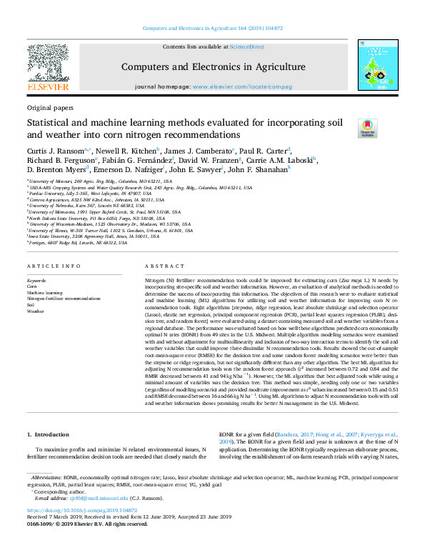
Nitrogen (N) fertilizer recommendation tools could be improved for estimating corn (Zea mays L.) N needs by incorporating site-specific soil and weather information. However, an evaluation of analytical methods is needed to determine the success of incorporating this information. The objectives of this research were to evaluate statistical and machine learning (ML) algorithms for utilizing soil and weather information for improving corn N recommendation tools. Eight algorithms [stepwise, ridge regression, least absolute shrinkage and selection operator (Lasso), elastic net regression, principal component regression (PCR), partial least squares regression (PLSR), decision tree, and random forest] were evaluated using a dataset containing measured soil and weather variables from a regional database. The performance was evaluated based on how well these algorithms predicted corn economically optimal N rates (EONR) from 49 sites in the U.S. Midwest. Multiple algorithm modeling scenarios were examined with and without adjustment for multicollinearity and inclusion of two-way interaction terms to identify the soil and weather variables that could improve three dissimilar N recommendation tools. Results showed the out-of-sample root-mean-square error (RMSE) for the decision tree and some random forest modeling scenarios were better than the stepwise or ridge regression, but not significantly different than any other algorithm. The best ML algorithm for adjusting N recommendation tools was the random forest approach (r2 increased between 0.72 and 0.84 and the RMSE decreased between 41 and 94 kg N ha−1). However, the ML algorithm that best adjusted tools while using a minimal amount of variables was the decision tree. This method was simple, needing only one or two variables (regardless of modeling scenario) and provided moderate improvement as r2 values increased between 0.15 and 0.51 and RMSE decreased between 16 and 66 kg N ha−1. Using ML algorithms to adjust N recommendation tools with soil and weather information shows promising results for better N management in the U.S. Midwest.
Available at: http://works.bepress.com/john-sawyer/427/

This article is published as Ransom, Curtis J., Newell R. Kitchen, James J. Camberato, Paul R. Carter, Richard B. Ferguson, Fabián G. Fernández, David W. Franzen et al. "Statistical and machine learning methods evaluated for incorporating soil and weather into corn nitrogen recommendations." Computers and Electronics in Agriculture 164 (2019): 104872. doi: 10.1016/j.compag.2019.104872.